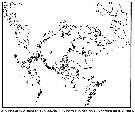|
|
 |
|
Calanoida ( Order ) |
|
|
|
Clausocalanoidea ( Superfamily ) |
|
|
|
Clausocalanidae ( Family ) |
|
|
|
Pseudocalanus ( Genus ) |
|
|
| |
Pseudocalanus moultoni Frost, 1989 (F,M) | |
| | | | | | | Ref.: | | | Frost, 1989 (p.541, figs.F,M); Sévigny & al., 1989 (p.321 & suiv.: genetic); Bucklin & al., 1998 (p.97, mol. Biol.); Bucklin & al., 1999 (p.239, molecular systematic); Bucklin & al., 2003 (p.335, tab. 2, figs.3, 4, mol. Biol.); G. Harding, 2004 (p.48, Rem.); Aarbakke & al., 2011 (p.1487, Table III, fig.2, 3, genetic analysis); Laakmann & al., 2013 (p.862, figs.1, 2, 3, 4, 5, Table 1, 2, 3, mol. Biol.) |  issued from : Frost B.W. in Can. J. Zool., 1989, 67. [Fig.17, p.542]. Female: A, habitus (lateral view); B, anterior portion of cephalosome (lateral view from left side). Male: C, habitus (lateral view); D, anterior portion of cephalosome (lateral view from right side). All scale bars = 0.1 mm.
| | | | | Compl. Ref.: | | | McLaren & al., 1989 (p.559, development vs. temperature); Shih & Marhue, 1991 (tab.2, 3); Mauchline, 1998 (tab.45, 48, 58); Logerwell & Ohman, 1999 (p.428, tab.1); Lenz & al., 2000 (p.338); Mackas & Galbraith, 2002 (p.725, tab.2a, 2b); Manning & Bucklin, 2005 (p.233, Table 1, figs.5, 12, 13); Galbraith, 2009 (pers. comm.); Homma & Yamaguchi, 2010 (p.965, Table 2); Homma & al., 2011 (p.29, Table 2, 3, abundance, feeding pattern: suspension feeders); | | | | NZ: | 4 | | |
|
Distribution map of Pseudocalanus moultoni by geographical zones
|
| | |  issued from : B.W. Frost in Can. J. Zool., 1989, 67. [p.529, Fig.3]. issued from : B.W. Frost in Can. J. Zool., 1989, 67. [p.529, Fig.3].
Geographical distribution of Pseudocalanus spp. |
| | | | Loc: | | | New York Bight, Georges Bank, G. of Maine, Nova Scotia, Spitsbergen, Norway (Balsfjorden), North Sea, Bering Sea, S Aleutian Basin, S Aleutian Is., G. of Alaska, British Columbia, Friday Harbor, Oregon, | | | | N: | 16 | | | | Lg.: | | | (122) F: 1,98-1,05; M: 1,38-0,98; {F: 1,05-1,98; M: 0,98-1,38} | | | | Rem.: | coast.
Characteristics according to Frost (1989): See limits of lenght measurements in the figure of the genus Pseudocalanus
Female: frontal part rounded in lateral view; mediodorsal surface of one or more of U1-U3 with sensillum; mediodorsal surface of U1-U3 with integumental pore; seminal receptacle small; cephalosome in lateral view not strongly tapered anteriorly; ratio of U3 lenght:width usually < 1.26; ratio Furca (lenght): U3 (width) usually < 1.04; ratio sizes Prosome:Urosome = 2.40 (2.29-2.57); ratio sizes of U3 length:width = 1.19 (1.09-1.31); Furca length: U3 width = 0.97 (0.87-1.08)
Male: P4 lenght (internal) B1:B2 < 1.5; ratio of segments of A1 (8-12):(20-21) < 2.2; mediodorsal surface of one or more of U2-U4 with sensillum; ratio sizes U2:U4 <1.37; ratio sizes Cephalosome:U2 > 5.07; ratio of the Furca length:width < 1.50; length of anterodorsal sensillum ≥ 16 microns; ratio sizes Cephalosome: U2 = 5.44 (5.11-5.66); ratio sizes U2:U4 = 1.25 (1.15-1.36); Furca lenght:width = 1.33 (1.14-1.48).
After Sévigny & al. (1989, p.322) because P. moultoni also possesses mediodorsal sensilla on the uromosal segments this species could not be readily distinguished from P. acuspes; however,they did not apparently co-occur in the areas studifd: P. moltoni was found on Browns Bank (South Nova Scotia) and at Chebucto Head and apparently was not present in large numbers in Bedford Basin where the dominant species was P. acuspes | | | Last update : 29/01/2015 | |
|
|
 Any use of this site for a publication will be mentioned with the following reference : Any use of this site for a publication will be mentioned with the following reference :
Razouls C., Desreumaux N., Kouwenberg J. and de Bovée F., 2005-2025. - Biodiversity of Marine Planktonic Copepods (morphology, geographical distribution and biological data). Sorbonne University, CNRS. Available at http://copepodes.obs-banyuls.fr/en [Accessed January 05, 2026] © copyright 2005-2025 Sorbonne University, CNRS
|
|
 |
 |





